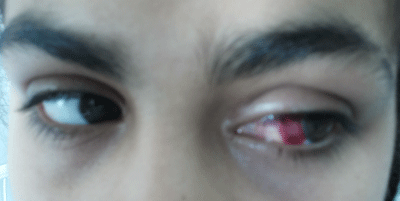
Special Article - Epilepsy and Seizure Disorders
Austin J Clin Neurol 2016; 3(2): 1092.
Subconjunctival Hemorrhages Following a Partial Seizure with Secondary Generalization: Atypical Presentation
Belfquih H* and Mostarchid BEI
Department of Neurosurgery, Mohammed V Military Teaching Hospital, Morocco
*Corresponding author: Hatim Belfquih, Department of Neurosurgery, Mohammed V Military Teaching Hospital, N°273, Hay Al Khiam III, Temara, Morocco
Received: September 18, 2016; Accepted: October 03, 2016; Published: October 05, 2016
Clinical Image
This 11years girl was admitted after a generalized tonic-clonic seizure. The neurological examination was normal, except for unilateral subconjunctival hemorrhages which had only occurred after the seizure (Figure 1). She did not have any allergies or drug reactions, or any bleeding disorders in the past and did not report head trauma during seizures. Her hemogram and coagulation profile were normal. Her serum electrolytes, hepatic and renal functions, magnetic resonance imaging brain and electroencephalogram were all normal.
Seizure-related subconjunctival hemorrhage is a rare finding that might be helpful for the diagnosis of an epileptic event in the absence of other objective signs [1,2]. The postulated mechanisms include ictal Valsalva maneuver during the tonic phase of a generalized tonic-clonic seizure resulting in capillary hypertension and rupture. The hemorrhage generally resolves spontaneously and do not need special treatment [3].
